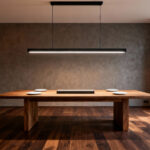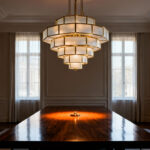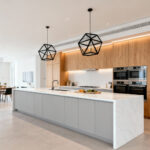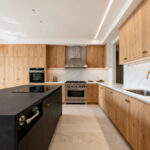Of all the places in a home, the dining table is where the magic really happens. It’s more than just wood and legs; it’s a landing strip for homework, a stage for late-night talks, a centerpiece for holiday feasts. It’s where generations connect. And floating right above it all is the light fixture—the single most important element for setting that scene.
I’ve spent over a decade designing spaces that work for people, not the other way around. And I can tell you, choosing that light isn’t just about picking something pretty. It’s about crafting an environment. The right light can make food look more delicious, conversations feel more intimate, and ensure everyone at the table, from a child to a grandparent, feels comfortable. The choices can feel endless, I know. But let’s walk through it together. These are the things I’ve learned that truly make a difference.
1. Choosing the Right Size Fixture
Getting the scale right is the first and most important step. It’s the foundation. A fixture that’s too small will look like a mistake—lost and lonely in the space above a grand table. Too large, and it can feel like a helmet, visually crushing the table and making people feel crowded. You’re aiming for a sense of belonging, where the light feels anchored to the table it serves.

Here’s the rule of thumb I always share: aim for a fixture with a diameter that is one-half to two-thirds the width of your table. So, for a 48-inch wide table, you’re looking for something in the 24 to 32-inch range. If you have a long, rectangular table, you might think about a linear fixture or a series of pendants that cover about two-thirds of the table’s length. I’ll never forget a client who installed a gorgeous, but tiny, crystal pendant over their substantial farmhouse table. It just looked sad, disconnected from the very gathering spot it was meant to illuminate. Balance is everything.
2. Perfecting the Fixture Height
Once you have the right size, hanging it at the right height is what makes it work. This single measurement is the difference between a comfortable glow and an annoying glare. It’s what keeps sightlines open so you can actually see the person you’re talking to across the table. Frankly, it’s a detail people mess up all the time.

The sweet spot is almost always between 30 and 36 inches from the tabletop to the bottom of the fixture. This is low enough to feel intimate and connected to the table, but high enough to stay out of the way. If your ceilings are taller than 9 feet, you can cheat it up a few inches, but function comes first. Before any electrician finalizes the height, I have my clients do a simple test: hang a balloon or a cardboard cutout on a string at the proposed height. Then, sit in every chair around the table. Does it block your view? Does it feel right? This real-world check catches issues that a tape measure alone will always miss.
3. The Charm of a Classic Chandelier
There’s a reason chandeliers have been the go-to for dining rooms for centuries. They bring a sense of occasion, turning a simple Tuesday night dinner into something a little more special. A classic chandelier isn’t just a light source; it’s a piece of sculpture that anchors the room. It’s a statement of permanence and tradition.

The beauty of a multi-arm chandelier is how it diffuses light. Instead of one harsh bulb pointing down, you have several smaller sources casting a softer, more flattering glow. This minimizes shadows on faces and makes everyone look their best—a subtle but powerful element of hospitality. When sized correctly (remember that one-half to two-thirds rule), a chandelier fills the vertical space in a room beautifully, drawing the eye up and making the entire space feel more intentional and grand.
4. Using Multiple Pendant Lights
While a single chandelier is a classic, lining up multiple pendants offers a more contemporary and often more practical solution, especially for longer tables. This approach creates a beautiful visual rhythm and, more importantly, distributes light much more evenly. No more shadowy spots at the ends of the table.

For a standard 6-to-8-foot rectangular table, three pendants is usually the magic number. It provides great coverage and feels balanced. One trick I love is to hang identical pendants but vary their heights ever so slightly—maybe an inch or two difference. It adds a subtle, dynamic layer to the design without looking chaotic. Before you have them installed, use painter’s tape on the ceiling to mark out the placement. It’s a simple five-minute step that lets you visualize the spacing and prevents the costly headache of realizing they’re just a little too close or too far apart.
5. Linear Fixtures for Rectangular Tables
Rectangular tables are the workhorses of most homes, but lighting them well can be tricky. A single round fixture often leaves the ends in the dark. This is where linear fixtures truly shine. Their elongated shape perfectly mirrors the table below, creating a clean, cohesive look while solving the problem of even light distribution.

Think of it as one simple solution for a common problem. For sizing, you want a linear fixture that’s about one-half to two-thirds the length of your table. An 84-inch table, for example, pairs perfectly with a fixture between 42 and 56 inches long. The styles are incredible these days, from minimalist LED strips that look like floating light, to industrial designs with wood and metal. They are wonderfully adaptable and are a fantastic solution for the multi-functional dining table so common in today’s multi-generational homes.
6. Incorporating a Dimmer Switch
Let me be very clear about this: a dimmer switch is not an optional extra. It is absolutely essential. I consider it a non-negotiable part of any good lighting plan, especially from a universal design perspective. Your dining space needs to shift from a bright, functional area for doing homework or sorting mail to a soft, intimate setting for a dinner party. A dimmer is the tool that lets you do that.

A dimmer gives you control over the mood, but it’s also a powerful accessibility feature. Bright light is crucial for someone with low vision, but can be painful for someone with sensory sensitivity or a migraine. A dimmer allows the lighting to adapt to the needs of every single person at the table. Just make sure the dimmer you buy is compatible with your bulbs—LEDs, in particular, need specific types. A dimmer doesn’t just create atmosphere; it creates an inclusive space.
7. Warm vs. Cool Light Temperature
Here’s an insider tip that makes a world of difference: the color of your light is just as important as the brightness. Light temperature is measured on the Kelvin (K) scale. Higher numbers (4000K+) are cool and blue-white like office lighting, while lower numbers (around 2700K) are warm and golden, like candlelight. For a dining room, there’s no debate. You want warm.

Warm light (aim for 2700K) is inviting, cozy, and makes food look incredibly appetizing. Cool light, on the other hand, can feel sterile and clinical, and it has a nasty habit of making food look grey and unappealing. If your dining room has ever felt a little “off” and you can’t put your finger on why, check your light bulbs. Swapping out cool-toned bulbs for 2700K warm-white LEDs can transform the entire feel of the room for less than twenty dollars. It’s the easiest and most impactful upgrade you can make.
8. Matching Lighting Style to Your Decor
The light fixture is your chance to inject personality into the dining room. It’s the room’s jewelry. But that doesn’t mean it should feel out of place. The goal is cohesion, choosing a fixture that speaks the same design language as your furniture, textiles, and art. A well-chosen light will feel like it was always meant to be there.

Take a look around your room. Do you have clean, modern lines? A minimalist geometric fixture or a simple drum pendant might be perfect. Is your style more rustic or farmhouse? Look for fixtures with wrought iron, reclaimed wood, or seeded glass. For a traditional space, you can’t go wrong with the timeless elegance of brass or crystal. The key is to find a piece that complements the room, not competes with it. It should be the focal point, but one that enhances everything around it.
9. Materials Matter: Glass, Metal, and Wood
The material of your fixture does more than just define its style; it shapes the light itself. Each material plays with light in a totally different way, and understanding this helps you choose a fixture that not only looks good, but feels good. This is where design gets really interesting.

Clear glass will sparkle and refract light, which can be beautiful but also create glare. Frosted, opal, or seeded glass, on the other hand, diffuses the light, creating a soft, even glow that’s much easier on the eyes. Metal, especially with an opaque shade, will direct all the light downward in a focused pool—great for task lighting. Wood and fabric absorb some light, creating a warmer, cozier, and more muted ambiance. Think about what you want the light to do. Do you need bright, focused light for tasks, or a gentle, ambient glow for conversation? The material will get you there.
10. Energy Efficiency with LED Bulbs
Let’s talk practicality. Your dining room light is probably on a lot, making it the perfect place to embrace energy efficiency. Honestly, with today’s technology, there’s no reason not to be using LED bulbs. They have completely changed the game for home lighting, and they’ve come so far from the cold, harsh LEDs of a decade ago.

Modern LEDs use up to 80% less energy and can last for 20 years or more. That means huge savings on your electricity bill and—a point I love to make—far fewer trips up a ladder to change a bulb, which is a fantastic safety and convenience feature for everyone. The key is to buy the right ones. Look for “warm white” (2700K) and make sure the box says “dimmable” if you’re using a dimmer. You can get the beautiful, warm ambiance of an old incandescent bulb without the energy waste. It’s a win-win.
11. Centering the Fixture Perfectly
This one might sound obvious, but it’s a detail that can make or break the whole room’s design. The light fixture must be centered over your dining table, not centered in the room. This is a common mistake I see all the time, especially in open-concept homes where the dining area isn’t perfectly symmetrical.

The relationship is between the table and the light. They are a pair. When the light is centered on the table, it anchors the entire dining zone and makes it feel intentional and grounded. An off-center light just looks wrong, creating visual tension and unevenly lighting the surface. Get out your tape measure, find the exact center of your tabletop, and use a plumb bob or a laser level to transfer that spot straight up to the ceiling. That’s your target.
12. Lighting for Round Dining Tables
Round tables are fantastic for conversation. There’s no head of the table, everyone is equidistant, and the vibe is naturally communal and inclusive. The lighting above should honor that wonderful circular flow. The best choice is almost always a single, centrally hung fixture.

A round or drum-shaped pendant, or a chandelier with a circular form, will echo the shape of the table below and create a sense of harmony. The fixture’s diameter should follow our trusty rule: about one-half to two-thirds the diameter of the table. For a 60-inch round table, a fixture that’s 30-40 inches wide is perfect. This proportion keeps the fixture from overpowering the intimate setting you’re trying to create, providing a single, unifying source of light for everyone gathered around.
13. Lighting for Long Dining Tables
Long tables are wonderful for big family gatherings, but they pose a real lighting challenge: how do you make sure the people at the ends aren’t left in the dark? A single pendant just won’t cut it. This is where you need a strategy that distributes light evenly from one end to the other.

You have two excellent options. The first is a linear fixture, which we’ve already discussed. The second is a series of smaller pendants. The N+1 rule is a great guideline for spacing them: if you have three pendants (N=3), you divide the length of your table by four (N+1) to find the ideal spacing between them. This approach creates a beautiful visual cadence and ensures that every single place setting is perfectly and evenly lit.
14. Making a Statement
Your dining light is a prime opportunity to have some fun and show off your personality. A statement fixture can act as the functional art for the room, creating a dramatic focal point that sparks conversation. It can be something with an unexpected shape, a bold color, or an impressive scale.

But here’s the catch: a statement piece still has to do its job. It can be as wild and artistic as you want, as long as it follows the basic rules of good lighting. It still needs to be sized proportionally to the table, hung at the right height, and—most importantly—it can’t create terrible glare. The most successful statement fixtures are those that manage to be both beautiful and functional, adding character without sacrificing comfort.
15. The Flexibility of Adjustable Height
Here’s a feature that’s a secret weapon for future-proofing your home: an adjustable-height fixture. This is a core concept in universal design—creating spaces that can adapt as your needs change. A fixture on a chain or a retractable cord system offers incredible flexibility.

Think about it. You can lower the light for a cozy, intimate dinner for two. You can raise it up a few inches to create a broader pool of light when the kids are doing a big art project or you’re hosting a game night. If you get a new, taller dining table in a few years, you don’t need a new light fixture. An adjustable fixture is ready for whatever life throws at it, ensuring your lighting is always perfectly tuned to the moment.
16. The Critical Task of Avoiding Glare
Nothing ruins a meal faster than a light bulb glaring in your eyes. Glare is more than just an annoyance; it causes eye strain and can be particularly uncomfortable for older adults or anyone with visual sensitivities. Good dining room lighting should be felt, not seen. The goal is a beautiful glow, not a harsh spotlight.

The best way to combat glare is to choose fixtures where the bulb itself is shielded from view. This could be a fixture with a fabric shade, a frosted glass diffuser, or a deep bowl that directs light downward. Avoid clear glass shades with exposed, bright bulbs at all costs. And this is another reason a dimmer switch is so critical—it allows you to dial down the intensity to a comfortable level. Always consider the source of the light from the perspective of someone sitting at the table.
17. Considering Your Ceiling Height
Your ceiling height is a major factor in what kind of fixture will work in your space. What looks magnificent in a room with 12-foot ceilings can feel comically large and oppressive in a room with standard 8-foot ceilings. The key is to match the fixture’s vertical presence to the room’s scale.

For standard 8-foot ceilings, stick with fixtures that have a less imposing profile. For ceilings lower than that, a semi-flush or flush-mount fixture might be your best bet to ensure you still have proper clearance over the table. On the flip side, high ceilings (9 feet and up) are your invitation to go bigger and bolder. You have the space for a dramatic, multi-tiered chandelier or a long, dangling pendant. A good guideline is to add about 3 inches to your hanging height for every extra foot of ceiling height over 8 feet, keeping that all-important 30-36 inch space above the table.
18. Building a Scene with Layered Light
A single overhead fixture, no matter how perfect, can create a flat, one-dimensional look. The real secret to a professionally designed space is layered lighting. This means using multiple sources of light to build a warm, dynamic, and flexible environment. Think of it as painting with light.

You want three main layers. Your fixture over the table provides the task lighting. The general, room-filling light from recessed cans or a central flush-mount is your ambient light. And finally, smaller lamps on a sideboard, picture lights over art, or sconces on a feature wall provide your accent light. By putting each of these layers on a separate dimmer, you gain complete control, allowing you to craft the perfect atmosphere for any occasion. This approach adds depth and sophistication and banishes harsh shadows for good.
19. Embracing Smart Lighting
Smart lighting has moved from a techy gimmick to a genuinely useful tool for creating more accessible and convenient homes. With a simple voice command or a tap on your phone, you can transform the lighting in your dining room. This is a game-changer, especially in a multi-generational or accessibility-conscious home.

Imagine being able to say, “Hey Google, set the lights for dinner,” and have them dim to a perfect warm glow. Or creating a “Homework” scene that provides bright, cool-toned light for focus. For someone with mobility challenges, being able to control the lights without getting up is incredibly empowering. You can start simply by swapping your current bulbs for smart bulbs, or you can install a fully integrated system with smart switches. It’s an investment in convenience and control that truly enhances daily life.
20. Smart, Budget-Friendly Solutions
Creating a beautiful and functional dining space doesn’t have to drain your bank account. I’m a firm believer that good design should be accessible to everyone, and that includes being mindful of budget. You can achieve a high-end look and feel with some strategic choices.

Often, a simple, elegant pendant light can be more impactful and far less expensive than an ornate chandelier. Shopping at flea markets, estate sales, or online marketplaces can unearth unique, affordable treasures. And don’t underestimate the power of a simple upgrade. Sometimes, just swapping out a dated shade or replacing old bulbs with warm, dimmable LEDs is all a fixture needs to feel new again. The most important investments are the ones you can’t see: a quality dimmer switch and the right LED bulbs. They pay for themselves in ambiance and energy savings over time.
21. Installation Tips and a Dose of Caution
You’ve done the research and picked the perfect fixture. Now for the final, crucial step: installation. Getting this right is paramount for both safety and aesthetics. While swapping out a simple, lightweight fixture can be a DIY job for a confident homeowner, my advice is to always err on the side of caution.

First things first: always turn off the power at the breaker before you do anything. No exceptions. Make sure the electrical box in your ceiling is rated to hold the weight of your new fixture; heavy chandeliers often require extra bracing. If you need to move a junction box to center the light over your table, or if you’re dealing with a very heavy or complicated fixture, please hire a licensed electrician. It’s a small cost for the peace of mind that comes from knowing it’s done safely and correctly.
22. Creating That Perfect Ambiance
At the end of the day, all of these tips—about size, height, color, and style—are in service of one ultimate goal: creating ambiance. It’s that intangible quality that makes a space feel right. It’s the warm, welcoming glow that invites people to pull up a chair, to linger over dessert, to share one more story.

That perfect ambiance is a recipe. It’s the warmth of a 2700K bulb, the flexibility of a dimmer switch, the soft, even glow from a layered lighting plan, and the visual harmony of a perfectly placed fixture. Studies have even shown that warm, soft lighting can enhance our perception of taste. When all these elements come together, the light above your dining table stops being just a utility and becomes an active participant in the life of your home, quietly helping you make memories that will last a lifetime.
Illuminating Your Life Around the Table
The light fixture over your dining table is so much more than a way to see your plate. It’s the conductor of your family’s orchestra. It sets the tempo for conversations, adds sparkle to celebrations, and wraps everyday meals in a feeling of warmth and togetherness. By being thoughtful about how you light this space, you’re not just decorating; you’re designing for connection.
Whether you land on a classic chandelier, a row of sleek pendants, or a dramatic statement piece, the principles of good design hold true. It’s about creating a space that works for everyone, anticipates your family’s changing needs, and feels welcoming to every single person who gathers there. Because that’s what a home is all about. With these ideas in your back pocket, you’re ready to choose a light that doesn’t just illuminate your table, but enriches the life that happens around it.






